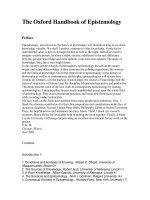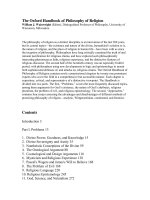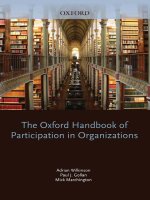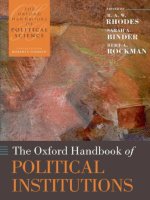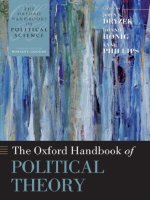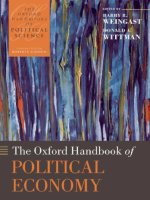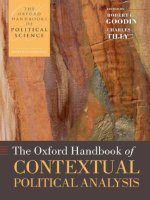- Trang chủ >>
- Khoa Học Tự Nhiên >>
- Vật lý
the oxford handbook of philosophy of religion dec 2004
Bạn đang xem bản rút gọn của tài liệu. Xem và tải ngay bản đầy đủ của tài liệu tại đây (5.67 MB, 561 trang )
The Oxford Handbook of
Philosophy of Religion
WILLIAM J. WAINWRIGHT,
Editor
OXFORD UNIVERSITY PRESS
the oxford handbook of
PHILOSOPHY
OF RELIGION
OXFORD HANDBOOKS IN PHILOSOPHY
PAUL K. MOSER, general editor
Series Advisory Board
ROBERT AUDI
University of Nebraska
MARTHA NUSSBAUM
University of Chicago
ALVIN PLANTINGA
University of Notre Dame
ERNEST SOSA
Brown University
the oxford handbook of
PHILOSOPHY
OF RELIGION
Edited by
WILLIAM J. WAINWRIGHT
1
2005
1
Oxford New York
Auckland Bangkok Buenos Aires Cape Town Chennai
Dar es Salaam Delhi Hong Kong Istanbul Karachi Kolkata
Kuala Lumpur Madrid Melbourne Mexico City Mumbai
Nairobi Sa˜o Paulo Shanghai Taipei Tokyo Toronto
Copyright ᭧ 2005 by Oxford University Press, Inc.
Published by Oxford University Press, Inc.
198 Madison Avenue, New York, New York 10016
www.oup.com
Oxford is a registered trademark of Oxford University Press
All rights reserved. No part of this publication may be reproduced,
stored in a retrieval system, or transmitted, in any form or by any means,
electronic, mechanical, photocopying, recording, or otherwise,
without the prior permission of Oxford University Press.
Library of Congress Cataloging-in-Publication Data
The Oxford handbook of philosophy of religion / edited by William J. Wainwright.
p. cm.—(Oxford handbooks in philosophy)
Includes bibliographical references and index.
ISBN 0-19-513809-0
1. Religion—Philosophy. I. Wainwright, William J. II. Series.
BL51.O94 2004
210—dc22 2004043890
135798642
Printed in the United States of America
on acid-free paper
TO MIMI, REBECCA, SARAH, CHANTAL, AND NICHOLAS
This page intentionally left blank
Contents
Contributors, ix
Introduction, 3
William J. Wainwright
Part I Problems
1. Divine Power, Goodness, and Knowledge, 15
William L. Rowe
2. Divine Sovereignty and Aseity, 35
William E. Mann
3. Nontheistic Conceptions of the Divine, 59
Paul J. Griffiths
4. The Ontological Argument, 80
Brian Leftow
5. Cosmological and Design Arguments, 116
Alexander R. Pruss and Richard M. Gale
6. Mysticism and Religious Experience, 138
Jerome I. Gellman
7. Pascal’s Wagers and James’s Will to Believe, 168
Jeffrey Jordan
8. The Problem of Evil, 188
Peter van Inwagen
viii contents
9. Religious Language, 220
William P. Alston
10. Religious Epistemology, 245
Nicholas Wolterstorff
11. God, Science, and Naturalism, 272
Paul Draper
12. Miracles, 304
George I. Mavrodes
13. Faith and Revelation, 323
C. Stephen Evans
14. Morality and Religion, 344
Linda Zagzebski
15. Death and the Afterlife, 366
Lynne Rudder Baker
16. Religious Diversity: Familiar Problems, Novel
Opportunities, 392
Philip L. Quinn
Part II Approaches
17. Analytic Philosophy of Religion, 421
William Hasker
18. Wittgensteinianism: Logic, Reality, and God, 447
D. Z. Phillips
19. Continental Philosophy of Religion, 472
Merold Westphal
20. Feminism and Analytic Philosophy of Religion, 494
Sarah Coakley
Index, 527
Contributors
william p. alston Professor of Philosophy Emeritus, Syracuse University.
lynne rudder baker Professor of Philosophy, University of Massachusetts–
Amherst.
sarah coakley Edward Mallinckrodt Professor of Divinity, Divinity School,
Harvard University.
paul draper Professor of Philosophy, Florida International University.
c. stephen evans University Professor of Philosophy and Humanities, Baylor
University.
richard m. gale Professor of Philosophy Emeritus, University of Pittsburgh.
jerome i. gellman Professor of Philosophy, Ben Gurion University of the
Negev.
paul j. griffiths Schmitt Professor of Catholic Studies, University of Illinois–
Chicago.
william hasker Professor of Philosophy Emeritus, Huntington College.
jeffrey jordan Associate Professor of Philosophy, University of Delaware.
brian leftow Nolloth Professor of Philosophy of the Christian Religion,
University of Oxford.
william e. mann Marsh Professor of Intellectual and Moral Philosophy,
University of Vermont.
george i. mavrodes Professor of Philosophy Emeritus, University of
Michigan.
x contributors
d. z. phillips Danforth Professor of the Philosophy of Religion, Claremont
Graduate University and Rush Rhees Research Professor, University of Wales–
Swansea.
alexander r. pruss Assistant Professor of Philosophy, Georgetown Univer-
sity.
philip l. quinn John A. O’Brien Professor of Philosophy, University of Notre
Dame.
william l. rowe Professor of Philosophy, Purdue University.
peter van inwagen John Cardinal O’Hara Professor of Philosophy, Univer-
sity of Notre Dame.
william j. wainwright Distinguished Professor of Philosophy Emeritus,
University of Wisconsin–Milwaukee.
merold westphal Distinguished Professor of Philosophy, Fordham Univer-
sity.
nicholas wolterstorff Noah Porter Professor of Philosophical Theology
Emeritus, Yale Divinity School.
linda zagzebski Kingfisher College Chair of the Philosophy of Religion and
Ethics, University of Oklahoma.
the oxford handbook of
PHILOSOPHY
OF RELIGION
This page intentionally left blank
INTRODUCTION
william j. wainwright
The expression “philosophy of religion” did not come into general use until the
nineteenth century, when it was employed to refer to the articulation and criticism
of humanity’s religious consciousness and its cultural expressions in thought, lan-
guage, feeling, and practice. Historically, philosophical reflection on religious
themes had two foci: first, God or Brahman or Nirvana or whatever else the object
of religious thought, attitudes, feelings, and practice was believed to be, and,
second, the human religious subject, that is, the thoughts, attitudes, feelings, and
practices themselves. The first sort of philosophical reflection has had a long
history. In the West, for example, discussions of the nature of God (whether he
is unchanging, say, or knows the future, whether his existence can be rationally
demonstrated, and the like) are incorporated in theological treatises such as An-
selm’s Proslogion and Monologion, Thomas Aquinas’s Summas, Maimonides’ Guide
for the Perplexed, and al-Ghazali’s Incoherence of the Philosophers. They also form
part of influential metaphysical systems like Plato’s, Plotinus’s, Descartes’, and
Leibniz’s. Hindu Vedanta and classical Buddhism included sophisticated discus-
sions of the nature of the Brahman and of the Buddha, respectively. Many con-
temporary philosophers of religion continue to be engaged with these topics (see,
for example, chapters 1 through 5 and 8).
The most salient feature of this sort of philosophy of religion is its attempts
to establish truths about God or the Absolute on the basis of unaided reason.
Aquinas is instructive. Some truths about God can be known only with the help
of revelation. Examples are his triune nature and incarnation. Other truths about
him, such as his existence, simplicity, wisdom, and power, are included in his
4 introduction
revelation to us but can also be known through reason. And Aquinas proceeds
to show how reason can establish them. What we would today call philosophy of
religion (or natural theology) is thus an integral part of his systematic theology.
Early modern philosophers like Descartes, Leibniz, and Locke are only incidentally
concerned with purely theological issues, but they too insist that some important
truths about God can be established by purely philosophical reflection.
The notion that we should accept only those religious beliefs that can be
established by reason was not commonly expressed until the later part of the
seventeenth century, however, and not widely embraced until adopted by the
eighteenth-century Enlightenment. The consequences of the new commitment to
reason alone depended on whether important religious truths could be established
by natural reason. Deists believed that they could. Human reason can prove the
existence of God and immortality and discover basic moral principles. Because
these religious beliefs are the only ones that can be established by unaided human
reason, they alone are required of everyone. They are also the only beliefs needed
for religious worship and practice. Beliefs wholly or partly based on some alleged
revelation, on the other hand, are needless at best and pernicious at worst. Others,
such as Hume, adopted a more skeptical attitude toward reason’s possibilities. In
their view, reason is unable to show that “God exists” or that any other important
religious claim is significantly more probable than not. The only proper attitude
for a reasonable person to take, therefore, is disbelief (atheism) or unbelief (ag-
nosticism). The result of this insistence on reason alone was thus that religion
either became desiccated, reduced to a few simple beliefs distilled from the rich
traditional systems that had given life to them, or ceased to be a live option.
Reaction was inevitable, and took two forms. One was a shift from theoretical
to practical (moral) reason. Kant, for example, was convinced that “theoretical”
or “speculative” reason could neither prove nor disprove God’s existence or the
immortality of the soul. Practical reason, on the other hand, provided a firm basis
for a religion lying within the “boundaries of reason alone.” The existence of God
and an afterlife can’t be established by theoretical reason. A belief in them, how-
ever, is a necessary presupposition of morality. Others, such as Friedrich Schleier-
macher, shifted their attention from intellectual belief and moral conduct to re-
ligious feelings and experience. In their view, the latter, and not the former, are
the root of humanity’s religious life. Both approaches were widely influential in
the nineteenth and early twentieth century. The first fell into neglect with the
waning of philosophical idealism in the first half of the twentieth century, al-
though interest in it has recently resurfaced (see chapter 14). The second has
continued to be attractive to many important philosophers of religion (see chap-
ters 6 and 10).
Philosophy of religion was comparatively neglected by academic philosophers
in the first half of the twentieth century. There were several reasons for this. One
was the widespread conviction that the traditional “proofs” were bankrupt. Be-
introduction 5
lievers and nonbelievers alike were persuaded that Hume and Kant had clearly
exposed their fatal weaknesses. Another was the demise of nineteenth-century
idealism. The twentieth-century heirs of the German and Anglo-American ide-
alists (Hastings Rashdall, W. R. Sorley, A. C. Ewing, and A. E. Taylor, among oth-
ers) had many interesting things to say about God, immortality, and humanity’s
religious life. But their views increasingly fell on deaf ears as analytic philosophy
replaced idealism as the dominant approach among English-speaking academics.
(The “process philosophy” of A. N. Whitehead and his followers emerged as an
alternative to idealism and analytic philosophy that could accommodate religious
interests. It was never more than a minority viewpoint, however, and finds itself
today in much the same position that philosophical idealism was in in the early
part of the twentieth century; its demise too seems immanent.) This is not to say
that nothing of interest to philosophers of religion was transpiring during this
period.
Five developments were especially important. The first was the impact of
theologians like Karl Barth, Emil Brunner, and Paul Tillich on philosophers in-
terested in religion. The second was the influence of religious existentialism, in-
cluding both the rediscovery of Søren Kierkegaard and the work of contempo-
raries like Gabriel Marcel and Martin Buber. A third was the renewal of Thomism
by Jacques Maritain, Etienne Gilson, and others. A fourth was the rise of religious
phenomenology; Rudolf Otto and others tried to accurately describe human re-
ligious experience as it appears to those who have it. Finally, philosophers who
were sympathetic to religious impulses and feelings yet deeply skeptical of religious
metaphysics attempted to reconstruct religion in a way that would preserve what
was thought to be valuable in it while discarding the chaff. Thus, John Dewey
suggested that the proper object of faith isn’t supernatural beings but “the unity
of all ideal ends arousing us to desire and actions,” or the “active relation” between
these ideals and the “forces in nature and society that generate and support” them.
In Dewey’s view, “any activity pursued in behalf of an ideal end against obstacles
and in spite of threats of personal loss because of a conviction of its general and
enduring value is religious in quality”
1
(see chapter 9).
After a half century of comparative neglect, analytic philosophers began to
take an interest in religion in the 1950s. Their attention was initially focused on
questions of religious language. Were sentences like “God forgives my sins” used
to express factual claims, or did they instead express the speaker’s attitudes or
commitments? If those who uttered them did express factual claims, what kind
of claims were they? Could they be empirically verified or falsified, for example,
and, if they could not, were they really cognitively meaningful? (For more on this
debate, see chapters 9, 10, 18, and 19.)
What was unanticipated was that the young analytic philosophers of religion
who were being trained during this period were to become responsible for a
resurgence of philosophical theology that began in the mid-1960s and continues
6 introduction
to dominate the field in English-speaking countries today. The revival was fueled
by a comparative loss of interest in the question of religious language’s cognitive
meaningfulness (it being generally thought that attempts to show that religious
sentences do not express true or false factual claims had been unsuccessful), and
a conviction that Hume’s and Kant’s allegedly devastating criticisms of philo-
sophical theology did not withstand careful scrutiny. On the positive side, devel-
opments in modal logic, probability theory, and so on offered tools for introduc-
ing a new clarity and rigor to traditional disputes.
Three features of the revival are especially noteworthy. The first was a renewed
interest in the scholastics and in seventeenth- and eighteenth-century philosoph-
ical theology. There were at least two reasons for this. One was the discovery that
issues central to the debates of the 1960s and 1970s had already been examined
with a sophistication and depth lacking in most nineteenth- and early twentieth-
century discussions of the same problems. The other was the fact that a significant
number of analytic philosophers of religion were practicing Christian or Jewish
theists. Figures such as Aquinas, Scotus, Maimonides, Samuel Clark, and Jonathan
Edwards were attractive models for these philosophers for two reasons. There is
a broad similarity between the philosophical approaches of these medieval and
early modern thinkers and contemporary analytic philosophers: precise defini-
tions, careful distinctions, and rigorous argumentation are features of both. In
addition, these predecessors were self-consciously Jewish or Christian; a conviction
of the truth or splendor of Judaism or Christianity pervades their work. They
were thus appealing models for contemporary philosophers of religion with sim-
ilar commitments.
A second feature of contemporary analytic philosophy of religion is the wide
array of topics it addresses. The first fifteen years or so of the period in question
were dominated by discussions of issues traditionally central to the philosophy of
religion: Is the concept of God coherent? Are there good reasons for thinking that
God exists? Is the existence of evil a decisive reason for denying God’s existence?
However, beginning in the 1980s, a number of Christian analytic philosophers
turned their attention to such specifically Christian doctrines as the Trinity, the
Incarnation, and the Atonement. Most of the articles and books on these topics
were attempts to show that the doctrines in question were coherent or rational.
But some were more interested in the bearing of theological doctrines on prob-
lems internal to the traditions that include them. Marilyn Adams, for example,
has argued that Christian martyrdom and Christ’s passion have important impli-
cations for Christian responses to the problem of evil, and Robert Oakes has made
similar claims for the Jewish mystical doctrine of God’s withdrawal (tzimzum).
Still other analytic philosophers of religion have tried to show that theism can
cast light on problems in other areas of philosophy—that it can give a better
account of the logical features of natural laws, for example, or of the nature of
introduction 7
numbers, sets, and other mathematical objects, or of the apparent objectivity of
moral claims.
2
(On the last, see chapter 14.)
A third characteristic of recent philosophy of religion is its turn toward epis-
temology. Medieval and seventeenth-century philosophical theology exhibited a
feature that has been insufficiently appreciated since the eighteenth century and
is especially prominent in Augustine and Anselm: its devotional setting. Anselm’s
inquiry, for instance, is punctuated by prayers to arouse his emotions and stir his
will. His inquiry is a divine-human collaboration in which he continually prays
for assistance and offers praise and thanksgiving for the light he has received. His
project as a whole is framed by a desire to “contemplate God” or “see God’s face.”
Anselm’s attempt to understand what he believes by finding reasons for it is largely
a means to this end.
3
Several hundred years later, Blaise Pascal argued that al-
though the evidence for the truth of the Christian religion is ambiguous, it is
sufficient to convince those who seek God or “have the living faith in their hearts.”
Reflection on the work of predecessors like these suggests two things. The first is
that the aim of philosophical theology is not, primarily, to convince nonbelievers
of the truth of religious claims but, rather, self-understanding: to enable the be-
liever to grasp the implications of, and reasons for, his or her religious beliefs.
The project, in other words, is faith in search of understanding. The second is
that a person’s attitudes, feelings, emotions, and aims have an important bearing
on his or her ability to discern religious truths. C. Stephen Evans, for example,
has suggested that faith may be a necessary condition of appreciating certain
reasons for religious belief. I have argued that a properly disposed heart may be
needed to grasp the force of evidence for theistic belief.
4
Common to much recent
religious epistemology is a rejection of any form of evidentialism that insists that
religious beliefs are reasonably held only if they are supported by evidence that
would convince any fair-minded, properly informed, and intelligent person re-
gardless of the state of his or her heart (see chapters 10 and 13).
As its history indicates, the aims of philosophers of religion can be quite
diverse. Arguments are sometimes employed apologetically. For example, Samuel
Clarke and William Paley attempted to construct proofs that would convince any
fair-minded and intelligent reader of God’s existence and providential government
of human affairs. These proofs had begun to lose their power to persuade educated
audiences by the end of the eighteenth century, however, and so Friedrich
Schleiermacher and others turned to religious feelings (a sense of absolute depen-
dence or of the unity of all things in the infinite) to justify religion to its “cultured
despisers.” But although Schleiermacher thought that the heart and not the head
is religion’s primary source, the aim of his argument was still apologetic.
Yet philosophy of religion can have other purposes. Theistic proofs, for ex-
ample, have been used to persuade nonbelievers of the truth of theism. But, as
we have seen, they can also be used devotionally, and this is sometimes their
8 introduction
primary purpose. Thus, Udayana’s Nyayakusumanjali (which can be roughly
translated as “A bouquet of arguments offered to God”) has three purposes: to
convince unbelievers, to strengthen the faithful, but also to please Siva “by pre-
senting it as an offering at his footstool.” Regardless of the success Udayana’s
arguments may or may not have had in achieving his first two goals, they have
value as a gift offered to God; their construction and presentation is an act of
worship.
5
Philosophy of religion is sometimes part of a larger philosophical project. For
example, for Hegel, religion is the self-representation of Absolute Spirit in feeling
and images. As such, it is a stage in a historical process that culminates in phi-
losophy (i.e., in Hegel’s philosophy!). Descartes provides another example. His
Meditations introduce ontological arguments for God’s existence to help resolve
skeptical doubts raised earlier in the text (see chapter 4).
Philosophy of religion can also be part of the so-called Enlightenment project.
Religious beliefs, institutions, and practices are critically examined in an attempt
to eliminate those that can’t survive the scrutiny of impartial reason. Hume’s
Dialogues and The Natural History of Religion and Kant’s reflections on religion
and morality are examples. The “hermeneutics of suspicion” practiced by Marx,
Nietzsche, and Freud is an extension of the same project. According to these
thinkers, religion is an expression of “false consciousness.” Its beliefs, feelings, and
practices lack rational support and rest on motives that cannot be consciously
acknowledged without destroying their credibility (see chapter 19).
Finally, philosophy of religion can be an attempt to make sense of, or account
for, religion, and not a reflection on its object (God, Nirvana, and the like). George
Santayana’s interpretation of religion as a kind of poetry, a feelingful contempla-
tion of ideal forms, is an example; Hume’s Natural History of Religion is another.
As these examples indicate, attempts of this sort are seldom neutral. Santayana,
for instance, takes naturalism for granted, and Hume is independently convinced
that historical religions are not only irrational but morally and socially pernicious.
Wittgensteinians, on the other hand, insist that their attempts to make sense of
religion are an exception to this rule; their project, they claim, is to simply un-
derstand religion, not judge it (see chapter 18).
Until quite recently, philosophy of religion has been somewhat myopic. Since
the only religions with which Western philosophers have been intimately ac-
quainted are Judaism and Christianity (and, to a lesser extent, Islam), it is not
surprising that they have focused their attention on theism. (Discussions of mys-
ticism have proved one noteworthy exception.) Increased knowledge of Asian and
other traditions has made this attitude seem unduly parochial. There is no in-
trinsic reason, however, why the tools of analytic or continental philosophy can’t
be profitably applied to non-Western doctrines and arguments, and good work is
currently being done in this vein by Stephen Phillips, Paul Williams, Steven Col-
lins, Gerald Larson, and a number of others. Paul Griffiths, for example, has
introduction 9
suggested that “perfect being theology” (the attempt to explore the implications
of the concept of a reality greater than which none can be thought) can be
deployed to explain (and criticize) the emergence of doctrines of the cosmic Bud-
dha in the Mahayana traditions. Work of this sort is essential because a defense
of one’s favored religion’s perspective should include reasons for preferring it to
its important competitors. The Western doctrine of creation ex nihilo, for in-
stance, should be compared with the Visistadvaitin notion that the world is best
viewed as God’s body.
6
Again, because the Buddhist’s claim that everything is
impermanent is logically incompatible with the assertion that God is eternal and
unchanging, both theists and Buddhists need to attend to the views of each other.
(For more on these issues, see chapters 3 and 16.)
Another weakness of contemporary philosophy of religion is that the analytic
and continental traditions have developed in comparative isolation from each
other. This is due to several factors. For one thing, analytic philosophers of reli-
gion are usually trained and housed in departments of philosophy, and most of
the best departments in English-speaking countries are dominated by analytic
philosophy. Continental philosophers of religion, on the other hand, are often
(although not always) trained and housed in departments of religion or theology.
Their interests, too, are different. Analytic philosophers of religion have tended
to focus on God or the religious object and on the rational credentials of claims
about it. Continental philosophy of religion has tended to focus on religion and
the human subject; it has also been more concerned with religion’s ethical im-
plications, especially its bearing on oppression and liberation.
The isolation of the two traditions is unfortunate because each needs what
the other has to offer. Analytic philosophers of religion, for instance, need to take
the hermeneutics of suspicion seriously, for, as Merold Westphal has said, they
have been largely blind “to the cognitive implications of finitude and sin.”
7
As a
result, they have usually ignored the ideological uses and abuses of theistic meta-
physics and the ethical issues this raises. The critiques of Marx, Nietzsche, Freud,
Jacques Derrida, and contemporary feminists can and should alert analytic phi-
losophers of religion to these perils (see chapters 19 and 20).
Continental philosophers of religion, on the other hand, too often ignore
questions of truth and rational adequacy. This is unfortunate for two closely
related reasons. The first is ethical: we fail to respect the men and women whose
beliefs and practices we examine if we don’t treat their claims to truth and rational
superiority with the same seriousness that they do. The second is this: if Chris-
tianity, say, or Buddhism is true, it matters infinitely. So if either is a live possi-
bility, a deeply serious concern with its truth or falsity, its reasonableness or
unreasonableness, is the only rational option. Inattention or indifference to the
truth and rational credentials of the traditions one examines is a clear indication
that one doesn’t take them as live possibilities, and hence doesn’t invest them
with the same importance or seriousness that their adherents do.
10 introduction
There are some indications that analytic and continental philosophers of re-
ligion are beginning to learn from each other. One can only hope that this trend
increases in the future.
The Oxford Handbook of Philosophy of Religion is divided into two parts. Part
1 covers the most frequently discussed problems in the field. Part 2 consists of
essays assessing the advantages and disadvantages of the four currently most in-
fluential ways of doing philosophy of religion; each is by a well-known practitioner
of the way he or she discusses. The essays in Part 2 are a unique feature of this
volume and are important for two reasons. First, one’s philosophical approach
affects one’s selection of problems and the way one frames them, and this, in
turn, affects one’s results. For example, followers of Emmanuel Levinas or feminist
philosophers of religion have different takes on the problem of evil than do an-
alytic philosophers. No picture of the philosophy of religion that ignores them
can be complete. Second, although the analytic approach dominates the practice
of philosophy of religion in English-speaking countries and is beginning to make
significant inroads on the continent, there are other historically important and
potentially illuminating ways of doing philosophy of religion. It is therefore im-
portant that a general reference work of this sort acquaint the reader with the
variety of approaches to the discipline.
The twenty chapters of this volume are written by prominent experts in the
field. Each chapter is expository, critical, and representative of a distinctive view-
point. In being expository, the chapters formulate and elucidate important com-
peting positions on their topic (e.g., religious experience or the problem of evil)
or the history and nature of the philosophical approach to the philosophy of
religion that they are discussing (the analytic, say, or feminist). In being critical,
the chapters carefully assess the views presented on their topics or the strengths
and alleged weakness of their approach to the philosophy of religion. Readers will
thus see not only what the prominent views and approaches in philosophy of
religion are but encounter noteworthy criticisms of them as well. In being rep-
resentative of a distinctive viewpoint the chapters present their authors’ own views
on the topic or approach. Readers will thereby encounter not only exposition and
criticism but the substantial development of a viewpoint on the subject under
discussion by a well-known author in the discipline. Finally, in addition to ex-
position, criticism, and original philosophical development, each chapter includes
topical bibliographies identifying key works in the field. It is our hope that the
Handbook’s combination of topical and methodological comprehensiveness, crit-
icism, and original philosophical development will provide the reader with a
unique and invaluable reference work on the philosophy of religion.
introduction 11
NOTES
1. John Dewey, A Common Faith (New Haven: Yale University Press, 1934), 42, 50–
51, 27.
2. See Marilyn McCord Adams, Horrendous Evils and the Goodness of God (Ithaca,
N.Y.: Cornell University Press, 1999), and Robert Oakes, “Creation as Theodicy: A De-
fense of a Kabbalistic Approach to Evil,” Faith and Philosophy 14 (1997): 510–21. For at-
tempts to offer theistic accounts of natural laws, mathematical objects, and moral claims
see, e.g., Del Ratzsch, “Nomo(theo)logical Necessity,” and Christopher Menzel, “Theism,
Platonism, and the Metaphysics of Mathematics,” both in Christian Theism and the
Problems of Philosophy, ed. Michael D. Beaty (Notre Dame, Ind.: University of Notre
Dame Press, 1990), 184–207 and 208–29, respectively; Philip L. Quinn, Divine Commands
and Moral Requirements (Oxford: Clarendon Press, 1978); and Robert M. Adams, Finite
and Infinite Goods (New York: Oxford University Press, 1999).
3. See Marilyn McCord Adams, “Praying the Proslogion: Anselm’s Theological
Method,” in The Rationality of Belief and the Plurality of Faith, ed. Thomas D. Senor
(Ithaca, N.Y.: Cornell University Press, 1995), 13–39.
4. See C. Stephen Evans, Passionate Reason: Making Sense of Kierkegaard’s Philo-
sophical Fragments (Bloomington: Indiana University Press, 1992), and William J. Wain-
wright, Reason and the Heart (Ithaca, N.Y.: Cornell University Press, 1995).
5. John Clayton, “Piety and the Proofs,” Religious Studies 26 (1990): 19–42.
6. It should be noted, however, that, on the Visistadvaitin view, bodies are abso-
lutely dependent on souls although souls are not dependent on bodies. So the differ-
ences between the two views should not be exaggerated. See William J. Wainwright, Phi-
losophy of Religion, 2d edition (Belmont, Calif.: Wadsworth, 1998), 192–96.
7. Merold Westphal, “Traditional Theism, the AAR and the APA,” in God, Philoso-
phy, and Academic Culture, ed. William J. Wainwright (Atlanta: Scholars Press, 1996),
21–27.
This page intentionally left blank
part i
PROBLEMS
This page intentionally left blank
